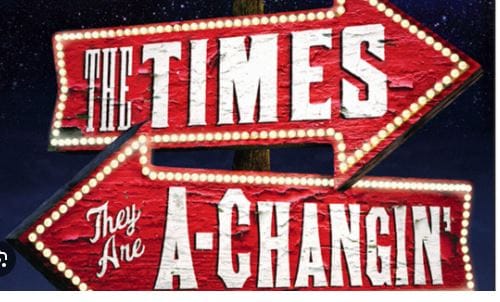Stagflation: The Times They Are A-Changin
Bob Dylan's song "The Times They Are A-Changin'" became an anthem for change and a commentary on the social upheavals of the 1960s. However, its message is timeless and can be applied to various periods of economic uncertainty, including those characterized by stagflation.

Bob Dylan's song "The Times They Are A-Changin'" became an anthem for change and a commentary on the social upheavals of the 1960s. However, its message is timeless and can be applied to various periods of economic uncertainty, including those characterized by stagflation. The song speaks to the necessity of acknowledging and adapting to changing circumstances, a message that resonates strongly with the economic and social challenges posed by stagflation.
During periods of stagflation, societies face the dual challenge of stagnant economic growth and rising inflation, which often leads to widespread disillusionment and calls for significant policy changes. "The Times They Are A-Changin'" captures this sentiment of upheaval and the urgent need for adaptation, mirroring the economic realities of stagflation where traditional economic policies and assumptions are upended.
In the context of today's economic challenges, whether they involve stagflation or other forms of economic uncertainty, Dylan's song remains relevant. It serves as a reminder that change is inevitable and that the resilience and willingness to adapt are crucial for navigating through difficult times. The song encourages listeners to be proactive and embrace change, rather than resisting it, a message that is particularly pertinent for policymakers, businesses, and individuals alike when facing the complex challenges of stagflation.
Thus, while "The Times They Are A-Changin'" may not explicitly address economic themes, its call for awareness, adaptation, and action in the face of change makes it thematically resonant with the experiences of those living through periods of stagflation and economic uncertainty
Stagflation is an economic phenomenon that combines stagnant economic growth, high unemployment, and high inflation. It's a challenging scenario for economic policymakers because the usual tools to combat inflation (tightening monetary policy) can exacerbate unemployment and stagnation, while measures to reduce unemployment (expanding monetary policy) can heighten inflation.
Understanding Stagflation
Traditional economic theories often depicted a trade-off between inflation and unemployment, famously illustrated by the Phillips Curve, which suggested that higher inflation came with lower unemployment, and vice versa. However, stagflation presents a scenario that contradicts this relationship, showing that it's possible to have both high inflation and high unemployment simultaneously.
Causes: Several factors can lead to stagflation, including:
- Supply Shocks: Sudden increases in the prices of key commodities (like oil), which raise production costs and consumer prices, leading to inflation, while also slowing economic growth due to increased costs for businesses and consumers.
- Poor Economic Policies: Policies that lead to an oversupply of money (hyperinflation) can also stagnate economic growth if the money does not reach productive investments.
- Regulatory or Fiscal Burdens: Excessive regulation or high taxes can also stifle business growth while contributing to inflation through increased costs.
Historical Examples of Stagflation
1. The 1970s Oil Crisis (Global, especially the United States and United Kingdom): The most famous example of stagflation occurred in the 1970s, triggered by the OPEC oil embargo in 1973 and the Iranian Revolution in 1979. These events led to a dramatic increase in oil prices, which, coupled with expansionary fiscal and monetary policies in previous years, resulted in high inflation and unemployment. In the US, inflation reached double digits, peaking at over 13% in 1979, while unemployment rose to 9% by 1975.
2. The United Kingdom in the 1970s: Similar to the US, the UK experienced stagflation in the 1970s, with inflation reaching over 24% in 1975. The causes were multifaceted, including rising oil prices, but also labor strikes and the government's inability to control inflation or stimulate growth effectively.
3. The "Lost Decade" in Japan (1990s): While Japan's situation in the 1990s was more characterized by deflationary pressures, it also experienced aspects of stagflation. After the asset bubble burst in the early 1990s, Japan faced a prolonged period of economic stagnation and mild deflation, with intermittent periods of inflation. This scenario was somewhat unique, as the inflationary periods were not as pronounced, but the stagnation and difficulty in achieving sustainable economic growth were similar to stagflation.
Impact of Stagflation
The impact of stagflation is broadly negative, affecting both the macroeconomy and individuals:
- Economic Growth: Stagnant growth means fewer job opportunities and lower income growth, affecting living standards.
- Inflation: High inflation erodes purchasing power, particularly harming those on fixed incomes or in lower-income brackets.
- Policy Dilemmas: Stagflation creates a policy bind, as traditional tools to combat inflation can worsen unemployment, and vice versa.
Stagflation remains one of the most challenging economic phenomena for policymakers. Its occurrence in the last 100 years has prompted a reevaluation of economic theories and policies, particularly around the management of supply shocks and the use of monetary policy. The examples from the 1970s to the 1990s show that while the triggers and contexts may vary, the impacts are consistently challenging, leading to significant economic hardship and necessitating innovative policy responses. Understanding stagflation's causes, effects, and historical contexts is crucial for developing strategies to mitigate its impacts should similar conditions arise in the future











